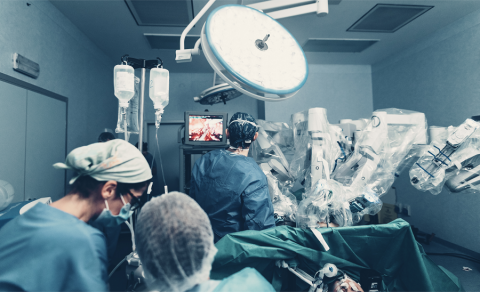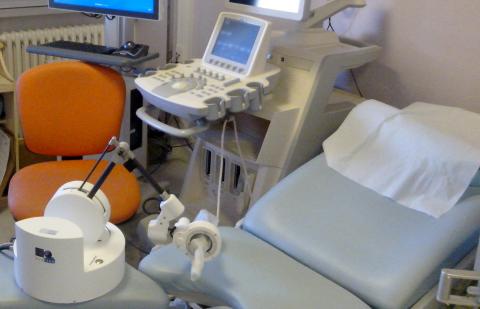
Robots in the Surgical Sphere
Interview with Marie-Aude Vitrani
Surgical robots, which were rare only 20 years ago, are increasingly present in hospitals despite their high cost. Not only do they make ultra-precise surgeries possible, they also offer greater comfort to surgeons.
Marie-Aude Vitrani is an associate professor in robotics, a researcher at ISIR (the University’s robotics lab), the co-director of the Institut universitaire d'ingénierie en santé, and is involved in the development of these new surgical assistants. Here, Vitrani explains their advantages, limitations and the impact they can have on medical teams.
How did robotics enter the surgical sphere?
Marie-Aude Vitrani: The first surgical robots appeared in the 1980s and came from the industrial sector. These articulated arms coupled with a navigation system, which are safe for operating theatres, are used to precisely position instruments in neurosurgery. Then in the 1990s, they were used in orthopedic surgery, which has the advantage of being performed on a rigid, non-deformable material: bone.
Thereafter, engineers and surgeons tried to create robotic devices to intervene on soft tissues, such as cardiac or pulmonary organs. But these innovations are still difficult to implement today.
The advent of minimally invasive surgery marked a turning point in the use of these robots, didn't it?
M.-A. V.: Minimally invasive surgery, which is performed through small orifices, makes it possible to reduce the risk of complications and the hospitalization and recovery time for the patient. Beneficial for patients, this type of surgery is difficult for surgeons to perform. The operations are long, tiring and are performed in difficult postures. They lose comfort, go from three-dimensional to two-dimensional vision and their mobility is reduced. At the end of the 1990s, engineers therefore sought to develop robots that would allow surgeons to regain comfort and dexterity.
The DaVinci robot is today the most famous of them. What makes it so special?
M.-A. V.: Conceived some twenty years ago, this surgical robot is now used in many hospitals. Valued at several million euros, it allows, for the first time, for practitioners to operate on their patients remotely.

Avec le robot DaVinci, le chirurgien opère à distance du patient.
Sitting at a console, the surgeon controls, via joysticks, the camera and the articulated instruments grafted on the four arms of the robot that reproduce the movements of the hand. Fully immersed in the operating field, the doctor benefits from three-dimensional vision, sensory feedback, freedom of movement and greater dexterity to perform minimally invasive surgeries. While this robot gives the surgeon an intuitive gesture similar to that of open surgery, it has one drawback: it cuts them off from the rest of the medical team.
At ISIR, you are developing new types of robots. What are their specificities?
M.-A. V.: In our team, we are working on another form of device: co-manipulated robots. With this type of robot, the surgeon is in the operating room with their patient. They use the robot alongside the team. The surgeon uses their regular instruments, but this time, they are attached to a robotic arm placed on the operating table. This arm will filter out the practitioner's tremors and offer them intuitive aids to facilitate their practice, such as holding an ultrasound probe during a biopsy.
Many practitioners are still hesitant to use minimally invasive surgery due to a lack of regular practice, as not all hospitals are equipped with robots like DaVinci. Thanks to the tools we are developing, we hope to reassure them and offer them greater comfort for this type of operation, compensating for fatigue and ensuring a safer and more precise procedure.

Robot co-manipulé développé par Marie-Aude Vitrani et Pierre Mozer.
Since 2009, we have developed and tested, with urology professor Pierre Mozer, a robotic device that has been transferred to an industrialist. This device, initially used for prostate biopsies, is currently being studied for use in uterine biopsies. We are developing robots using the same principle of co-manipulation for digestive and gynecological surgery.
You work closely with surgeons. How does this multidisciplinary collaboration work?
M.-A. V.: Engineers and surgeons work hand in hand. I attend their operations and the surgeons come to our engineering laboratories. We see each other regularly, particularly for the co-supervision of doctoral candidates or medical interns.
This collaboration makes it possible to develop robots with more advanced functions adapted to the needs of practitioners: movement compensation, reduction of tremors, better visualization of instruments, organs, targets to be reached, etc. It is the combination of the surgeon's movements and those of the robot that improves for example, gestures and posture.
We also work with anthropologists to analyze the impact of these robotic devices on the relationships within the medical team and the role of each person within the block. For example, if you give the surgeon the opportunity to hold their endoscope alone thanks to the robot, you need to think about how to continue to involve the student who was doing this task.
Is the use of these new instruments included in the training of young doctors?
M.-A. V.: Our objective is to democratize minimally invasive surgery by giving teams the means to make it the standard surgery. While these are now the rule in major hospitals, it is still not widely used in France.
This is why the intelligent devices we develop are also designed to be used in training. While they assist expert surgeons, they also allow novices to train and be guided in order to better understand surgical procedures. We are also working with the Faculty of Medicine on the implementation of interventions to raise awareness and initiate doctors, young and old, to these devices.
